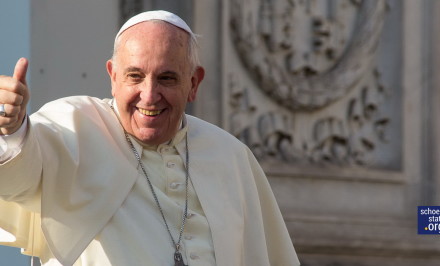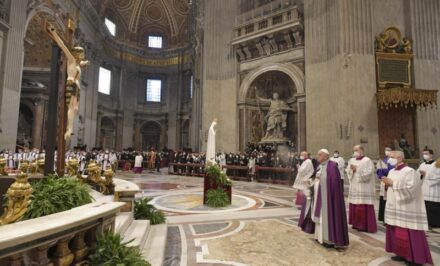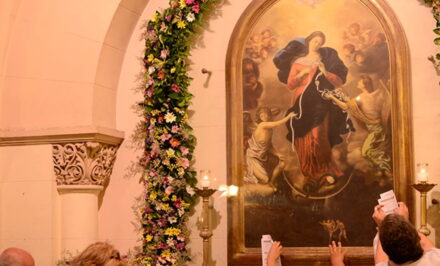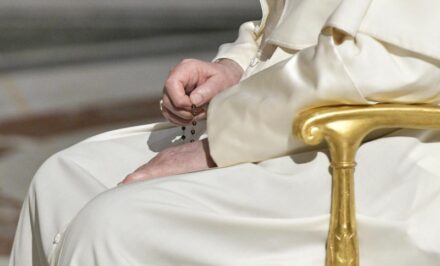 Victor Codina SJ. The ecclesial and world impact of Pope Francis is not fundamentally attributed to his discourses and talks, which many have not been read completely, but to his symbolic gestures (embracing children, kissing the handicapped, eating with the Vatican workers in the cafeteria, living outside the Apostolic Palace, traveling in a small run-around car…) and some of his images and graphic expressions captured and easily understood by everyone. These phrases, coined amidst a homily or a text, have great evocative and determining power; they are like the modern version of the parables and images used by Jesus in his time.
Victor Codina SJ. The ecclesial and world impact of Pope Francis is not fundamentally attributed to his discourses and talks, which many have not been read completely, but to his symbolic gestures (embracing children, kissing the handicapped, eating with the Vatican workers in the cafeteria, living outside the Apostolic Palace, traveling in a small run-around car…) and some of his images and graphic expressions captured and easily understood by everyone. These phrases, coined amidst a homily or a text, have great evocative and determining power; they are like the modern version of the parables and images used by Jesus in his time.

Therefore, instead of offering a systematic and academic explanation of Francis’ thought on evangelization, I will limit myself to present seven expressive images that in some way recap in symbolic form what is most essential and new in his evangelizing pastoral proposal.
1. Open doors
The Church is not a jail, nor a museum, nor a medieval fortress with walls, pits and a bridge. It is not like Franz Kafka’s description of that mysterious castle, where a mystery man lived.
The Church is a home with open doors and flowers in the windows, which welcomes everyone, regardless of where they come from and offers everyone a table with bread and wine. It is a place of mercy, not a place of torture nor a customs office that controls everything. It is a paternal house, maternal, whose ecclesial icon is Mary who introduces Jesus to us and HE takes us to the FATHER. The Church reproduces in history the merciful heart of the FATHER that Jesus in his life and teaching revealed to us… a mercy that is affected/moved before the sufferings and sins of its children.
If Pope St. John XXIII said that with Vatican Council II the Church was opening her windows for a breath of fresh air in the Church, now Francisco has totally opened the doors of the Church to everyone, to Christians and non-Christians, to broken marriages, to homosexuals, to agnostics and non-believers. All are welcome.
2. Go out into the street
The open doors mean “ welcome” to all who come from outside and afar. But the Church is not to wait until they come to her doors, she is to go out into the street, go out to the outskirts, to the geographic and existential boundaries, even run the risk of being in an accident.
She is not a Church enclosed within herself, self-referring, occupied only with her scandals or clergy problems…but a Church who seeks what is lost, who goes out to encounter those in need, who travels the dusty roads of the world and listens to the clamor of the people, their difficulties and desires as Jesus of Nazareth did when he traveled through Galilee and Judea.
She is a Church in the state of mission – missionary – who “wanders the faith in the streets” and wants to go to the crossroads of history and dialogue with science, with cultures, with religions without fear because She knows that the Spirit of the Lord fills the universe and is the cause of all change.
This makes the Church not longing for the past but to open up for the future and to the signs of the times, to the new Areopagus/highest court. She is a Church on the way.
3. Battlefield hospital
In critical moments, wars, accidents, epidemics…the hospitals do not make complicated analyses nor long-term treatments, but help in emergency situations, where life is in danger.
The Church has to help also with personal and social emergencies, save, cure, suture, bandage the wounds of human suffering, save the threatened lives of children, women, aborigines, the elderly, the handicapped, heal the scars of people who suffer in the body or in the spirit. Is this not what Jesus did on the roads of Palestine? Did HE not heal the sick even on the Sabbath, showing that the person is before the law? Is this not what the good Samaritan did?
4. Church of the poor
The dream of Pope St. John XXIII upon beginning the Second Vatican Council, the option for the poor in the Latin American Church in Medellin and Puebla, the affirmation of Benedict XVI that “the option for the poor” is implicit in our faith in Christ, the affirmations of Aparecida that one cannot speak of God without speaking of the poor (no. 393)…are extended in the desire of Francis for a poor Church and a Church for the poor.
Evangelization has a social dimension– to evangelize is to make the Kingdom of God present, beginning with the Lord’s favorites: the poor, today reduced to rejected beings, to surplus masses.
The option for the poor of whom we are speaking about is not cultural, nor sociological nor political, but evangelical, biblical, theological. The poor, their religious piety, are a true theological place, a place where we are evangelized.
The Church cannot remain on the margin in the struggle for justice; for it She denounces the present unjust economic system, which discriminates and kills the poor. The Church cannot remain impassive before so much injustice and human suffering.
The constant smile of the Pope, his gestures and tenderness, his writings on the joy of the Gospel…could seem to us a false image of the Bishop of Rome. But Francis prophetically denounces the aspects of our society, which are contrary to the Gospel of the Kingdom: he has proclaimed a blunt “No” to the economy of exclusion and inequality which breeds violence; a “no” to the economy which crystallizes into unjust structures and which kills; a “No” to the globalization of indifference; a “no” to the idolatry of money; a “No” to hiding behind God to justify violence; a “No” to social insensitivity that is anesthetized before suffering; a “No” to arms. Francis updates the commandment to not kill and to defend the value of human life from its beginning to its ending.
Behind these “No’s” of Francis, a true evangelical image of the Church and world is drawn; a world closer to the Kingdom of God. Francis’ joy is not a worldly joy, nor the fruitfulness of an optimistic temperament, but the joy that springs forth from the Gospel of Jesus and from the power of his Spirit, the joy of the Church of the poor.
5. Spread the odor of the Gospel
Facing traditional attitudes, obsessed by orthodox doctrine and by the morality of causticity – especially on sexual topics – the Church must spread, especially, the perfume of the Gospel of Jesus, the joy of salvation in Christ, the kerygma, that is, the announcement of the Good News of Jesus, passing through the spiritual experience of the encounter with the Lord, even to mysticism.
One must concentrate on what is essential to the Gospel, what is most beautiful and attractive. Speak more about grace than the Law, speak more of Christ than the Church, more about the Word of God than the Pope. Maintain the hierarchy of truths, the newness of the Gospel, the joy of Easter.
6. Smell like the sheep
Facing clergy attitudes of pastors shut up in their offices, distant from the people, civil servants who seek careers or who are always at the airports…one must approach the people, “touch the flesh of Christ” in the poor, surpass all clericalism, worldliness and patriarchy, reform the papacy, recuperate the attitudes of Jesus the Good Shepherd who seeks the lost sheep and who carries it on his shoulders. One must have the “odor of a sheep,” of the people, of sweat, of dust, of pain and anxiety.
7. Evangelize with Spirit
To evangelize is not a heavy obligation, nor something we must do sadly or with anxiety; neither is it an activity which must be done while discouraged or impatient, but it is the fruitfulness of the joy of the Gospel, which motivates us to a joyful and comforting mission. But this means an evangelization with Spirit, the same Spirit that motivated the apostles at Pentecost and encourages and moves the Church of today to continue the mission of Jesus.
Evangelization supposes an encounter with the Resurrected Lord, the one who gives his Spirit to the disciples and converts a community of cowardly and timid apostles into witnesses of the Gospel, capable of giving their lives for the Lord Jesus and the Kingdom.
It is about announcing the Good News not only with words, but also with life. Of trusting in the power of the Spirit that sows seeds of the Kingdom everywhere and is a source of newness and life within and without the Church.
The Spirit makes us know Jesus, constitutes us as people of God; the Spirit makes the Kingdom present –becomes joy for Christians amidst tiredness and discouragement– is the root of our Easter hope. “Let us not have sad, funereal faces,” but let us transmit the joy of the Gospel. May hope not be robbed from us.
Conclusion: Lampedusa
Lampedusa is a small Italian island, twenty square kilometers with only 5,000 inhabitants, situated in the Mediterranean. At 205 kms, it borders with Sicily and at 111 kms with Tunisia. This arid island without water other than what comes from rain depends on fishing, agriculture and tourism. It has become famous for being the port of entry to Europe for thousands of undocumented immigrants coming from Africa and also the Middle East and Asia. In the last two decades, some 20,000 persons in search of better living conditions came to Lampedusa on barges and dories and have lost their lives on the journey.
Pope Francis traveled to this island on July 8, 2013. He did not want to make his first trip outside of Rome to New York, nor Brussels, nor Buenos Aires, but to Lampedusa to let out a cry to the world warning of the tragedy of the immigrants.
In Lampedusa, the Pope not only prayed for the dead, nor only hurled a bouquet of yellow and white flowers in memory of the victims, not only embraced the African migrants who had recently arrived, but wanted to awaken the awareness of a humanity that remains enclosed – as in a soap bubble – into the culture of wellbeing, of a humanity which has lost the sense of fraternal responsibility and has become incapable of taking care of the least protected persons or, inclusive, of nature itself.
In his message, Francis affirms that we are submerged in the globalization of indifference that our heart is anesthetized, and we are incapable of crying for the deaths of our brothers. Nobody feels responsible for these deaths. Francis repeats the Biblical words: “Cain, where is your brother?”
This trip of Francis to Lampedusa, his gestures and words, does it not summarize and symbolize the style of evangelization of a Church, moved by the Spirit, who goes out in preference to the poor and to the many who suffer, who opens her mother doors while she calls everyone to leave egotism aside and to live as brothers and sisters?
Does not the Lampedusa episode ooze out an odor of the Gospel? Does not Francis’ trip bring to life the image of the Good Shepherd who goes out in search of the lost sheep? The trip to Lampedusa is like a living parable of evangelization according to Pope Francis. If evangelizing is doing what Jesus did, evangelizing today is doing what Francis did in Lampedusa. This is our outline, our plan.
About the author
Víctor Codina is a Jesuit priest and Latin American theologian. He is originally from Spain, but since 1982, has lived in Bolivia. He studied philosophy and theology in Sant Cugat, Innsbruck and Rome. At present he is professor emeritus for the school of theology at the Catholic University of Bolivia in Cochabamba. He alternates his pastoral work with basic ecclesial communities and popular sectors.
His latest books are: NO EXTINGAIS EL ESPIRITU (DON’T EXTINGUISH THE SPIRIT) [Sal Terrae, Santander 2008], UNA IGLESIA NAZARENA (A NAZARENE CHURCH) [Sal Terrae, Santander 2010], DIARIO DE UN TEOLOGO DEL POSCONCILIO (DIARY OF A POSTCONCILIAR THEOLOGIAN) [San Pablo, Bogotá 2013], and DIOSITO NOS ACOMPANA SIEMPRE (GOD ALWAYS ACCOMPANYS US [Kipus, Cochabamba 2013].
Source: Vida Pastoral. Published by Religión Digital

Original Spanish: Translation: Carlos Cantú, Schoenstatt Family Federation, La Feria, Texas USA 01142015













